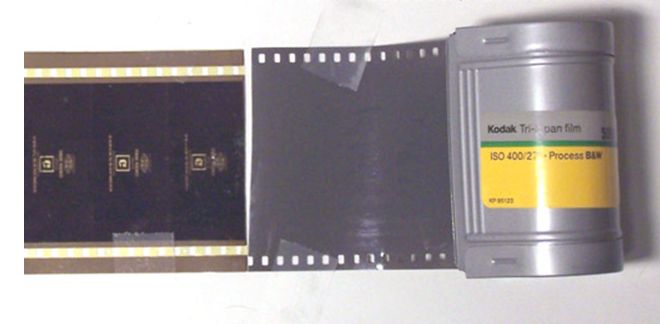|
|
 
|
|
Author
|
Topic: 70 mm perforations.
|
Stephen Furley
Film God

Posts: 3059
From: Coulsdon, Croydon, England
Registered: May 2002
|
 posted 05-08-2013 05:54 PM
posted 05-08-2013 05:54 PM




There is some 70 mm print stock for sale on Ebay. Not something that I would have any use for, but here are two different types, one with type I perforations, and the other with type II. Does anybody know what the difference is? Other than the usual Todd-AO type I've seen two other perforation types on 70 mm film, the old Fox Grandeur type, and KS type ones close to the edge of the film, as with 35 mm, for use in still camera backs, but neither of those would seem to be applicable to modern motion picture print stocks.
| IP: Logged
|
|
|
|
|
|
|
|
Stephen Furley
Film God

Posts: 3059
From: Coulsdon, Croydon, England
Registered: May 2002
|
 posted 05-11-2013 05:36 AM
posted 05-11-2013 05:36 AM




One type is describes as Kodak 2383 70mm Color Print Motion Picture Film 2500ft. The can labels say KODAK VISION Color Print film, and this type does indeed say Perforations thpe I on the label.
web page
The other type is described as Kodak 70mm 2480' Roll Color Print Film 5384 and there is no mention of perforation type on the label. The cans are silver.
http://www.ebay.co.uk/itm/Kodak-70mm-2480-Roll-Color-Print-Film-5384-/280652021597?pt=US_Camera_Film&hash=item415829ff5d
The length of the second type is interesting; 2500 ft is printed on the labels, but this has been struck through, and 2480 has be hand-written. The cans are described as sealed; did they leave the factory in this condition, and if so, why? Was 20 ft damaged during manufacture or finishing and had to be removed, if so it seems to have affected both cans, or was it removed for testing? Or was 20 ft removed for testing after sale, and the cans re-sealed?
The emulsion types do not mean anything to me, I used to know some of the pre-Vision camera negative types, but not print stocks.
| IP: Logged
|
|
Leo Enticknap
Film God

Posts: 7474
From: Loma Linda, CA
Registered: Jul 2000
|
 posted 05-11-2013 08:35 AM
posted 05-11-2013 08:35 AM





Kodak stock numbers work as follows:
1XXX - nitrate
2XXX - polyester (35 and 70)
3XXX - 16mm polyester
5XXX - triacetate (35 and 70)
7XXX - 16mm triacetate
2383 is Kodak's current bogstandard print film (2393 is the expensive, high silver, showprint stuff), launched in 1998 and still (just about) in production.
5384 was its predecessor but one, launched in 1982 and in use until 1993, when it was replaced by 5386 (which continued in production until 2002). Since 2002, 2383/93 have been the only print stocks in production.
So the 5384 must be at least a decade and a half old, and the 2383 up to a decade old. If you were thinking about making prints on it now, I guess that you'd have to print and process a test strip and take densitometry readings before doing the actual reel. Still, he claims to have seven reels left of the 2383, and if they've been stored relatively well that would be enough to do a feature film print relatively cheaply, if anyone is in the market for one and if any of the remaining labs that could print and process it are willing to experiment.
| IP: Logged
|
|
|
|
|
|
|
|
|
|
Stephen Furley
Film God

Posts: 3059
From: Coulsdon, Croydon, England
Registered: May 2002
|
 posted 05-11-2013 04:38 PM
posted 05-11-2013 04:38 PM




Fox Grandeur perfs are nothing like any other perfs on any 35, 65 or 70 mm stock. I was wondering if they ever had an official designation, or if they were just refered to as 'Grandeur perforations'
The position of the perfs relative to the edge of the strip is the same on 35 mm, 65 mm and 70 mm (still) film; I've just checked. 70 mm (Todd-AO) perforations obviously have to be basically the same as 65 mm perfs, since they have to be printed from 65 mm negatives. While I've never seen any actual film, only pictures, I think all of the wide film systems of 1929-30 except Grandeur used similar perforations to those on 35mm film, in terms of shape, pitch and distance from the edge of the strip. I have no idea why Fox used something totally different for Grandeur. I doubt if it was to get around somebody else's patents, or the other wide formats of the time would probably have had to do so as well.
Cinemascope 55 would have been an interesting one. Again, I don't have any film samples but looking at pictures the 55.625 mm negative stock has 'Foxhole' perfs, as does the proposed, but never actually used 6-perf print format. On the 8-perf negative they seem to be the same distance from the edge of the strip as they would be on a 35 mm mag print. On the proosed print format however they are positioned much further in, to make room for the six track magnetic sound on four stripes, in much the same way as on a 70 mm Todd-AO print. If 6-perf release prints had ever actually been used they would presumably have been contact printed from a 6-perf interneg, but how were the rushes printed? Were they 8-perf contact printed, or optically printed 35 mm reductions? If the original camera negatives would never be put through a continuous contact printer they would not need to have had short pitch perfs, but did they?
Could Jim mean the difference between 'short' negative and 'normal' print pitch on motion picture stocks. I don't know which pitch is used for still photography. It wouldn't matter much, some backs, including the Graflex one do not use the perforations, and can use unperforated film.
| IP: Logged
|
|
|
|
|
|
All times are Central (GMT -6:00)
|
|
Powered by Infopop Corporation
UBB.classicTM
6.3.1.2
The Film-Tech Forums are designed for various members related to the cinema industry to express their opinions, viewpoints and testimonials on various products, services and events based upon speculation, personal knowledge and factual information through use, therefore all views represented here allow no liability upon the publishers of this web site and the owners of said views assume no liability for any ill will resulting from these postings. The posts made here are for educational as well as entertainment purposes and as such anyone viewing this portion of the website must accept these views as statements of the author of that opinion
and agrees to release the authors from any and all liability.
|

 Home
Home
 Products
Products
 Store
Store
 Forum
Forum
 Warehouse
Warehouse
 Contact Us
Contact Us




 Printer-friendly view of this topic
Printer-friendly view of this topic














